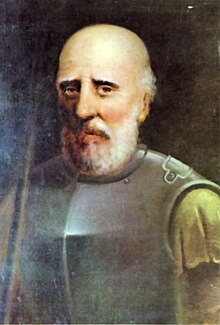Francisco de Carvajal
Francisco de Carvajal (* 1464 in Rágama de Arevalo, Salamanca ; † April 10, 1548 in Cusco , Peru ) was a Spanish officer and conquistador . Because of his cruelty he was feared as a demon of the Andes .
Life
Born as Francisco López y Gascón in Rágama de Arévalo, he studied at the University of Salamanca, from which his later reputation as a runaway monk was based. After a series of public scandals, Francisco was disinherited. He took the name Carvajal (or Carbajal) and served in 1503 under the Spanish military leader Gonzalo Fernández de Córdoba in southern Italy and in 1512 under Cardona in the battle of Ravenna . Carvajal fought in the further course of the Italian Wars under Pedro Navarro and Fabrizio Colonna for Emperor Charles V , including in 1525 in the Battle of Pavia . Since that battle he had the captured noblewoman Catalina de Leyton with him, who became a slave to him and later accompanied him to South America. In 1527 he participated in the Sacco di Roma and earned a small fortune.
Carvajal used these funds to embark overseas in 1536. In New Spain he became a military assistant to the Spanish viceroy Antonio de Mendoza there . After Peru was conquered, he was commissioned to guarantee the royal rights there and to help found the capital Lima . In the war between the supporters of Diego de Almagro and Francisco Pizarro in 1538 he stood on the latter's side. In 1542 he supported the provisional governor of Peru, Cristóbal Vaca de Castro , against Diego de Almagro el Mozo , the son and successor of Almagros, who was defeated in the Battle of Chupas and then taken as a prisoner to Cuzco, where he was executed with forty followers .
When Gonzalo Pizarro rebelled against the newly appointed governor of the king, Blasco Núñez de Vela , in 1544 , Carvajal, who was already over eighty and described as a giant, acted as his master. On October 28, 1544, the rebels captured Lima. The defeated governor was given a ship with which he could leave Peru. Gonzalo Pizarro then set up a regime that was characterized on the one hand by lavish folk festivals and on the other by bloody excesses, whereby his drunkard army master was able to perfect his already existing passion for hanging. The "demon of the Andes" eliminated countless opponents of Pizarro, so that in Peru the long common phrase "cruel como Carvajal" (cruel like Carvajal) arose.
The governor Blasco Núñez de Vela, disempowered by Gonzalo Pizarro, decided not to return to Spain, fearing that he would be held responsible for the defeat against the rebels. Instead, he raised an army of 600 to fight the rebels. On January 18, 1546 there was the Battle of Añaquio, in which the governor's army was defeated by the numerically stronger rebels. The captured Blasco Núñez de Vela was beheaded by an African slave. As a result of this defeat, Emperor Charles V , who also ruled as King Charles I of Spain, entrusted the President of the Real Audiencia of Lima , Pedro de la Gasca , with the removal of the rebel regime around Gonzalo Pizarro. After the failed secret negotiations between Pizarro and de la Gasca, led by intermediaries, the battle of Jaquijahuana took place on April 9, 1548 , in which the rebels were defeated. Francisco de Carvajal fought alongside Gonzalo Pizarro until the end of the battle, instead of capitulating or defying the enemy like a large number of rebels. The next day he was sentenced to death along with Gonzalo Pizzaro and other rebels and quartered after his execution in the Inca fortress of Sacsayhuamán .
literature
- Agustín de Zárate : Historia del descubrimiento y conquista del Perú , Historiadores Primitivos de Indias (tomo XXVI), Madrid 1947.
- Volker Ebersbach : Francisco Pizarro - gloss and misery of a conquistador , Verlag Neues Leben Berlin, 3rd edition 1986, p. 409 ff., ISBN 3-355-00200-3 .
Web links
- Biography on www.mcnbiografias.com (Spanish)
| personal data | |
|---|---|
| SURNAME | Carvajal, Francisco de |
| BRIEF DESCRIPTION | Spanish officer and conquistador |
| DATE OF BIRTH | 1464 |
| PLACE OF BIRTH | Rágama de Arevalo, Salamanca |
| DATE OF DEATH | April 10, 1548 |
| Place of death | Cusco , Peru |
